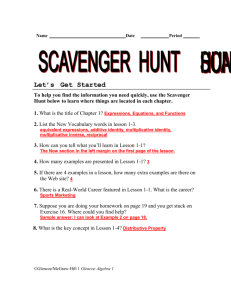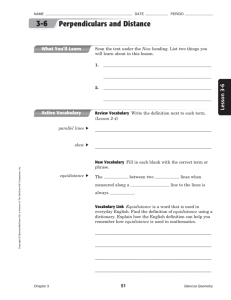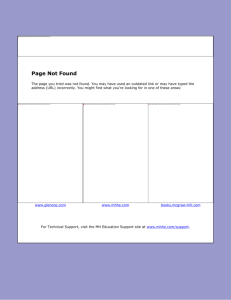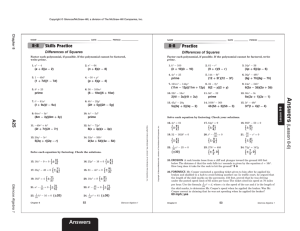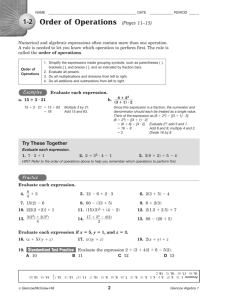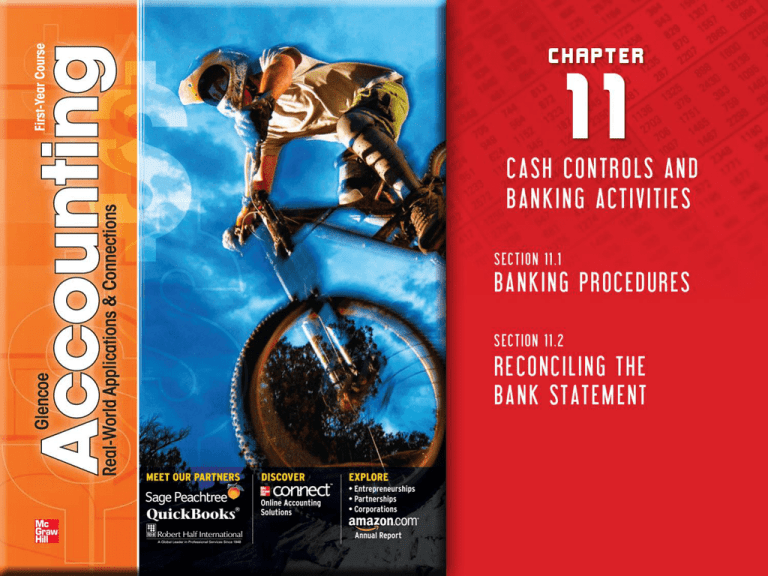
Internal controls are steps taken to
protect assets and keep reliable records.
The bank reconciliation is an important
internal control.
Glencoe Accounting
Copyright © by The McGraw-Hill Companies, Inc. All rights reserved.
Protecting Cash
Section 11.1
Banking Procedures
Internal Controls
Two ways to protect
cash:
External Controls
internal controls
Procedures within the business
that are designed to protect
cash and other assets and to
keep reliable records.
Glencoe Accounting
external controls
Measures and procedures
provided outside the business
to protect cash and other
assets.
Copyright © by The McGraw-Hill Companies, Inc. All rights reserved.
The Checking Account
Section 11.1
Banking Procedures
A checking account holds cash deposits made by the depositor,
whether a person or business, and allows them to write a check
against the balance.
checking account
An account that allows a person or business to deposit cash in a bank and then write
checks and make ATM withdrawals and purchases against the account balance.
depositor
A person or business that has cash on deposit in a bank.
check
A written order from a depositor telling the bank to pay a stated amount of cash to the
person or business named on the check.
Glencoe Accounting
Copyright © by The McGraw-Hill Companies, Inc. All rights reserved.
The Checking Account
Section 11.1
Banking Procedures
Protects cash
A checking account:
Provides a record
of transactions
Glencoe Accounting
Copyright © by The McGraw-Hill Companies, Inc. All rights reserved.
The Checking Account
Section 11.1
Banking Procedures
The Signature Card
signature card
A bank form containing the
signature(s) of the person(s)
authorized to write checks on
a checking account.
See page 282
Glencoe Accounting
Copyright © by The McGraw-Hill Companies, Inc. All rights reserved.
The Checking Account
Section 11.1
Banking Procedures
The Checkbook
Detachable check
Check stub
Numbered in sequence
See page 282
Glencoe Accounting
Copyright © by The McGraw-Hill Companies, Inc. All rights reserved.
The Checking Account
Section 11.1
Banking Procedures
The Printed Check
ABA number
Identifies the bank.
Speeds the handling
of printed checks.
See page 283
Glencoe Accounting
Copyright © by The McGraw-Hill Companies, Inc. All rights reserved.
The Checking Account
Section 11.1
Banking Procedures
The Deposit Slip
See page 283
deposit slip
A bank form used to list the
cash and checks to be
deposited.
Glencoe Accounting
Copyright © by The McGraw-Hill Companies, Inc. All rights reserved.
The Checking Account
Section 11.1
Banking Procedures
Completing a Deposit
1. Write the date on the Date line.
2. Indicate the total currency and
coins on the Cash line.
Glencoe Accounting
3. List checks separately by their
ABA numbers.
4. Add the amounts and enter
the total on the Total line.
Copyright © by The McGraw-Hill Companies, Inc. All rights reserved.
The Checking Account
Section 11.1
Banking Procedures
The depositor’s endorsement is needed to deposit a
check in a checking account.
endorsement
A check endorsement that includes only the
signature or stamp of the depositor. It does not
specify the new owner of the check.
Glencoe Accounting
Copyright © by The McGraw-Hill Companies, Inc. All rights reserved.
The Checking Account
Section 11.1
Banking Procedures
blank endorsement
A check endorsement that includes only the signature or
stamp of the depositor. It does not specify the new owner of
the check.
special endorsement
A check endorsement that a transfers ownership of the
check to a specific individual or business.
restrictive endorsement
A check endorsement that transfers ownership to a
specific owner and limits how the check may be handled (for
example, For Deposit Only).
Glencoe Accounting
Copyright © by The McGraw-Hill Companies, Inc. All rights reserved.
The Checking Account
Section 11.1
Banking Procedures
Recording a Deposit
Enter the date of deposit in the Add deposits line on the
check stub for the next unused check.
Enter the total amount of the deposit.
Add the deposit amounts to the amount on the Balance
brought forward line and enter the total on the Total line.
Glencoe Accounting
Copyright © by The McGraw-Hill Companies, Inc. All rights reserved.
The Checking Account
Section 11.1
Banking Procedures
Rules for Writing a Check
Complete checks in ink.
Complete the check stub before writing the check.
Glencoe Accounting
Copyright © by The McGraw-Hill Companies, Inc. All rights reserved.
The Checking Account
Section 11.1
Banking Procedures
Two Parts of the Check Stub
The upper part containing
the amount of the check,
the date, the name of the
payee, and the purpose of
the check.
The lower part containing a
record of how the
transaction affects the
checking account.
payee
The person or business to whom a check is
written or a note is payable.
Glencoe Accounting
Copyright © by The McGraw-Hill Companies, Inc. All rights reserved.
The Checking Account
Section 11.1
Banking Procedures
The Check Stub
Upper Part
Lower Part
See page 285
Glencoe Accounting
Copyright © by The McGraw-Hill Companies, Inc. All rights reserved.
The Checking Account
Section 11.1
Banking Procedures
Completing the Check
1.
2.
3.
4.
5.
Write the date the check is being issued.
Enter the payee’s name on the Pay To Order Of line.
Enter the amount of the check in numbers.
Write the dollar amount of the check in words.
The drawee requires that the check is signed by the
drawer.
drawee
The bank on which
the check is written.
drawer
The person who
signs a check.
Who do you
want to be?
___________
See page 285
Glencoe Accounting
Copyright © by The McGraw-Hill Companies, Inc. All rights reserved.
The Checking Account
Section 11.1
Banking Procedures
Voiding a check is necessary if a mistake is made
while writing a check.
voiding a check
Making a check unusable by writing the
word Void in ink across the front of the check.
Should you throw the voided
check away?
Glencoe Accounting
Copyright © by The McGraw-Hill Companies, Inc. All rights reserved.
Proving Cash
Section 11.2
Reconciling the
Bank Statement
Comparing the Cash in Bank account balance with the
checkbook is called proving cash.
Common Checkbook Errors
Faulty addition or
subtraction
Glencoe Accounting
Failure to record a
deposit or a check
A mistake in
copying the balance
forward amount to
the next check stub
Copyright © by The McGraw-Hill Companies, Inc. All rights reserved.
The Bank Statement
Section 11.2
Reconciling the
Bank Statement
Information in a Bank Statement
1. The checking account balance at the beginning of the period
2. A list of all deposits
3. A list of all checks paid by the bank
4. A list of any other deductions
5. The checking account balance at the end of the period
bank statement
An itemized record of all the transactions in a depositor’s
account over a given period, usually a month.
Glencoe Accounting
Copyright © by The McGraw-Hill Companies, Inc. All rights reserved.
The Bank Statement
Section 11.2
Reconciling the
Bank Statement
A bank usually returns canceled checks as imaged checks with
the bank statement.
canceled check
A check paid by the bank, deducted from the depositor’s
account, and returned with the bank statement to the
account holder.
imaged check
A copy of a canceled check; it is sent with the bank
statement in place of the original canceled check.
Glencoe Accounting
Copyright © by The McGraw-Hill Companies, Inc. All rights reserved.
The Bank Statement
Section 11.2
Reconciling the
Bank Statement
Reconciling the bank statement is also known as a
bank reconciliation.
reconciling the bank statement
The process of determining any differences between a bank
statement balance and a checkbook balance.
Glencoe Accounting
Copyright © by The McGraw-Hill Companies, Inc. All rights reserved.
The Bank Statement
Section 11.2
Reconciling the
Bank Statement
In banking terms, the word outstanding means “not yet received.”
What are outstanding checks?
outstanding check
A check that has been written but has not yet been
presented to the bank for payment.
Glencoe Accounting
Copyright © by The McGraw-Hill Companies, Inc. All rights reserved.
The Bank Statement
Section 11.2
Reconciling the
Bank Statement
In banking terms, the word outstanding means “not yet received.”
What are outstanding deposits?
outstanding deposit
A deposit that has been made and recorded in the
checkbook but does not yet appear on the bank statement.
Glencoe Accounting
Copyright © by The McGraw-Hill Companies, Inc. All rights reserved.
The Bank Statement
Section 11.2
Reconciling the
Bank Statement
Entering a Bank Service
Charge on the Check Stub
bank service charge
A fee the bank charges
for maintaining bank
records and processing
bank statement items for
the depositor.
See page 289
Glencoe Accounting
Copyright © by The McGraw-Hill Companies, Inc. All rights reserved.
The Bank Statement
Section 11.2
Reconciling the
Bank Statement
See page 290
Glencoe Accounting
Copyright © by The McGraw-Hill Companies, Inc. All rights reserved.
The Bank Statement
Section 10.1
Preparing Closing
Entries
Journalizing Bank Service Charges
Business Transaction
On November 1, Zip received the bank statement. A bank service charge of
$8 appeared on the statement.
See page 291
Glencoe Accounting
Copyright © by The McGraw-Hill Companies, Inc. All rights reserved.
The Bank Statement
Section 11.2
Reconciling the
Bank Statement
NSF stands for Not Sufficient Funds
What is an NSF check?
NSF check
A check returned to the depositor by the bank because the
drawer’s checking account does not have sufficient funds to
cover the amount; also called dishonored check.
Glencoe Accounting
Copyright © by The McGraw-Hill Companies, Inc. All rights reserved.
Question 1
You have just received your bank statement for the month. What are
the steps in reconciling the bank statement to the checkbook balance?
Step 1
compare checks on statement with the checks listed
in the checkbook stubs and place a check mark
beside the amount on the bank statement and check
stub; list the outstanding checks (those with no
check marks) and their amounts on the bank
reconciliation form.
(continued)
Glencoe Accounting
Copyright © by The McGraw-Hill Companies, Inc. All rights reserved.
Question 1
You have just received your bank statement for the month. What are
the steps in reconciling the bank statement to the checkbook balance?
Step 2
Enter the ending balance shown on the bank
statement in the proper box.
(continued)
Glencoe Accounting
Copyright © by The McGraw-Hill Companies, Inc. All rights reserved.
Question 1
You have just received your bank statement for the month. What are
the steps in reconciling the bank statement to the checkbook balance?
Step 3
Compare the deposits listed on the bank statement
to deposits in the checkbook. Enter the total of any
outstanding deposits on the bank reconciliation form.
Add this total to the bank statement balance and
enter the sum on the form.
(continued)
Glencoe Accounting
Copyright © by The McGraw-Hill Companies, Inc. All rights reserved.
Question 1
You have just received your bank statement for the month. What are
the steps in reconciling the bank statement to the checkbook balance?
Step 4
Subtract the total of the outstanding checks (Step 1)
from the amount calculated in Step 3. This is the
adjusted bank balance.
(continued)
Glencoe Accounting
Copyright © by The McGraw-Hill Companies, Inc. All rights reserved.
Question 1
You have just received your bank statement for the month. What are
the steps in reconciling the bank statement to the checkbook balance?
Step 5
Compare the adjusted bank balance and the
checkbook balance. When they agree, the bank
statement has been reconciled.
Glencoe Accounting
Copyright © by The McGraw-Hill Companies, Inc. All rights reserved.
Question 2
Do the following regarding the bank statement:
a) List at least two pieces of information that you can learn from
the monthly bank statement.
a)
You can find out a number of important facts from
the bank statement:
1. Checks that have been cashed by the payee
(cleared).
2. Deposits that have been received by the bank.
3. Any service fees that the bank assessed
during the period.
4. The beginning and ending balances.
(continued)
Glencoe Accounting
Copyright © by The McGraw-Hill Companies, Inc. All rights reserved.
Question 2
Do the following regarding the bank statement:
b) List at least two reasons why it is important to reconcile the
bank statement monthly.
b) Reconciling the bank statement monthly allows you to
do the following:
1. Determine an accurate cash balance.
2. Maintain accurate accounting records.
3. Maintain good internal control over cash.
Glencoe Accounting
Copyright © by The McGraw-Hill Companies, Inc. All rights reserved.
End of

